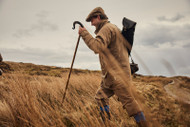How To Get The Right Fit For Your Shooting Jacket
Posted by Philip Morris and Son on 9th Nov 2023
When choosing a new shooting jacket, the most important thing to remember with the fit is that you want it for function, not style. Therefore, it doesn’t matter too much what it looks like, as long as it covers you in all the right places and doesn’t restrict your movement. Here, we take you through five key features of the fit that you should check.
Freedom of movement
This is the most important thing to get correct. If the jacket pulls across the shoulders or anywhere else when you try to swing the gun, it will restrict your ability to shoot. When trying the coat on, zip it up fully and then raise your arms and swing as if shooting a high bird. If you feel any restrictions, then try a bigger size or different cut of jacket.
In order to get the right kind of movement, the jacket might seem a little big for you in places. A great example of a jacket that fits most people really well is the Schoffel Ptarmigan Shooting Jacket range. In many cases, the owners find they look a bit baggy on the shoulders, but they are hugely popular because they don’t restrict movement.

Sleeves
Sleeve length can be an issue, particularly for taller wearers. You want enough length so that you won’t have an exposed wrist area when lifting the gun, but not too long a sleeve that it gets in the way of hand movement. Generally, if you stand in the jacket with your arms straight down and the sleeve ends just below the knuckles, the length will be about right.
When you try the jacket on, be sure to raise your arms as if shooting, with the jacket fully zipped up and check the sleeve is long enough. If the sleeve is too long, a style with a fully adjustable cuff (either Velcro or Popper) can sometimes be enough to manage this.
However, if this isn't the case, look for a style with a shorter cut arm. Generally speaking, Musto shooting jackets have fairly long sleeves, Schoffel and Harkila are fairly in the middle, and Barbour is often a bit shorter.
Length
You want your shooting jacket to be long enough to keep you dry, and not leave any exposed areas far enough down that rain will run safely onto you over trousers or leggings on a wet day. Generally, the upper thigh is a good length, but it is largely a personal preference. A fit that is cut too long for you can also be a hindrance: you don’t want to get the excess fabric of your nice new jacket caught when climbing a stile.
Hood
This feature is often overlooked when trying on a jacket. In most cases, it isn’t an issue, but occasionally, particularly for taller individuals, they can find the hood isn’t generous enough and pulls at the top of the head.
It’s also worth bearing in mind that you may wish to have space for ear defenders inside your hood. Too much hood fabric can often result in obscured vision, but most better shooting jacket brands will include an adjustable fit feature to manage this issue.

Body
Clearly, people come in all different shapes and sizes. There tends to be an underlying assumption amongst shooting jacket manufacturers that as you get taller, you also get wider, which is not necessarily the case. It can leave both the shorter, wider person, and the taller, thinner person struggling for the right fit. There are now jackets available for both builds.
Schoffel leads the way in this with some jackets like the Ptarmigan Classic Shooting Jacket being suited to a rounder figure, whilst the Ptarmigan Pro Shooting Jacket is suited to the slimmer build. If you are of the taller, thinner build, a shooting jacket with a drawcord both at the waist and on the lower hem can make a huge difference in fit, aiding both insulation retention and the look.

